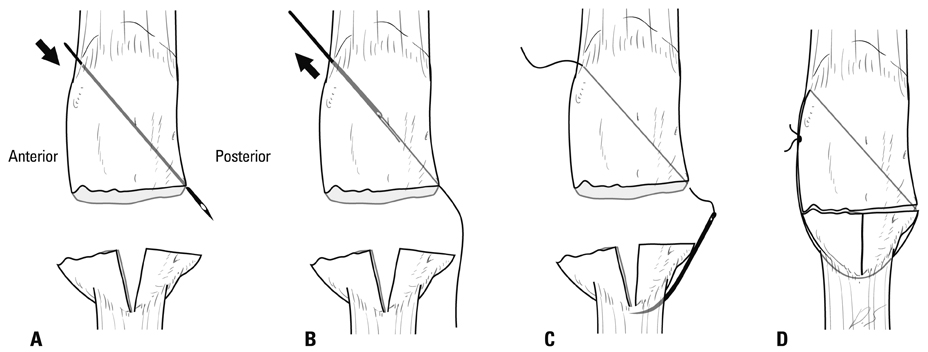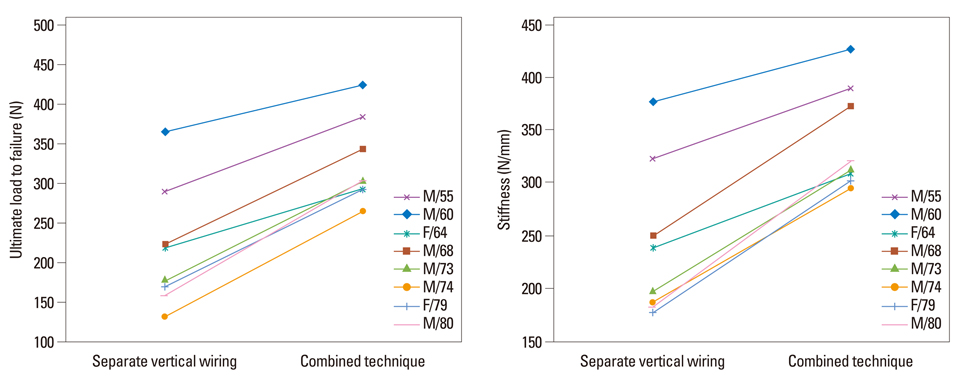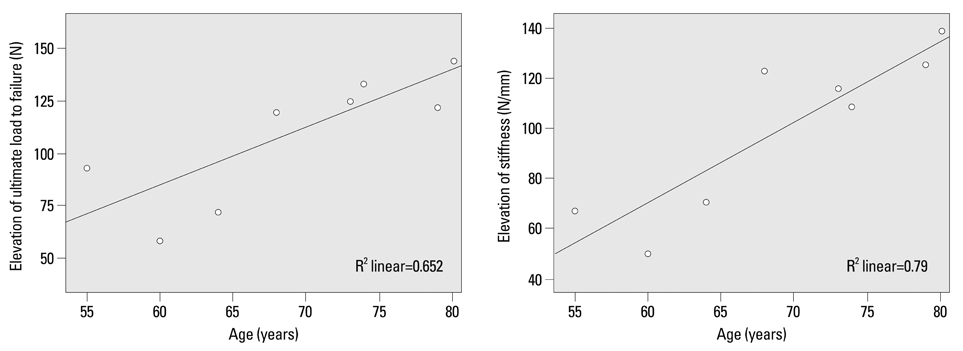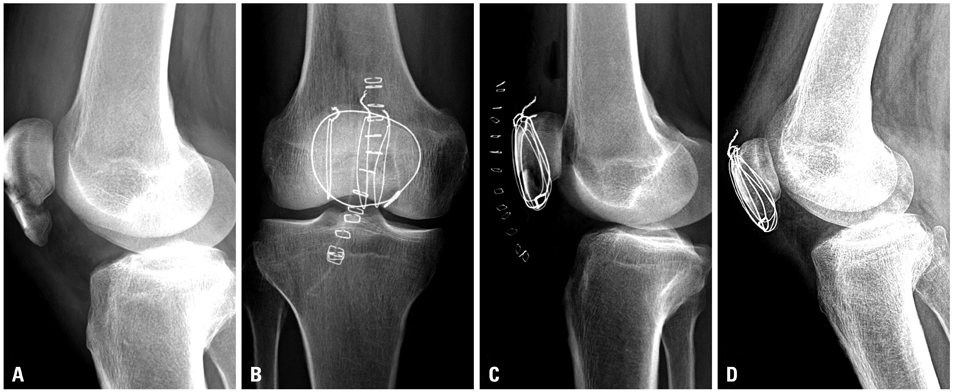Yonsei Med J.
2014 May;55(3):785-791. 10.3349/ymj.2014.55.3.785.
Separate Vertical Wiring for the Fixation of Comminuted Fractures of the Inferior Pole of the Patella
- Affiliations
-
- 1Department of Orthopaedic Surgery, Ajou University School of Medicine, Suwon, Korea.
- 2Department of Orthopaedic Surgery, Hallym University Sacred Heart Hospital, Anyang, Korea.
- 3Department of Orthopaedic Surgery, Daegu Fatima Hospital, Daegu, Korea.
- 4Department of Orthopaedic Surgery, Gangnam Severance Hospital, Yonsei University College of Medicine, Seoul, Korea. kyang@yuhs.ac
- KMID: 2068692
- DOI: http://doi.org/10.3349/ymj.2014.55.3.785
Abstract
- PURPOSE
Among patients over 50 years of age, separate vertical wiring alone may be insufficient for fixation of fractures of the inferior pole of the patella. Therefore, mechanical and clinical studies were performed in patients over the age of 50 to test the strength of augmentation of separate vertical wiring with cerclage wire (i.e., combined technique).
MATERIALS AND METHODS
Multiple osteotomies were performed to create four-part fractures in the inferior poles of eight pairs of cadaveric patellae. One patella from each pair was fixed with the separate wiring technique, while the other patella was fixed with a combined technique. The ultimate load to failure and stiffness of the fixation were subsequently measured. In a clinical study of 21 patients (average age of 64 years), comminuted fractures of the inferior pole of the patellae were treated using the combined technique. Operative parameters were recorded from which post-operative outcomes were evaluated.
RESULTS
For cadaveric patellae, whose mean age was 69 years, the mean ultimate loads to failure for the separate vertical wiring technique and the combined technique were 216.4+/-72.4 N and 324.9+/-50.6 N, respectively (p=0.012). The mean stiffness for the separate vertical wiring technique and the combined technique was 241.1+/-68.5 N/mm and 340.8+/-45.3 N/mm, respectively (p=0.012). In the clinical study, the mean clinical score at final follow-up was 28.1 points.
CONCLUSION
Augmentation of separate vertical wiring with cerclage wire provides enough strength for protected early exercise of the knee joint and uneventful healing.
Keyword
MeSH Terms
Figure
Reference
-
1. Cramer KE, Moed BR. Patellar Fractures: Contemporary Approach to Treatment. J Am Acad Orthop Surg. 1997; 5:323–331.
Article2. Harris RM. Fractures of the patella and injuries to the extensor mechanism. In : Rockwood CA, Green DP, Bucholz RW, editors. Rockwood and Green's Fractures in adults. 6th ed. Philadelphia: Lippincott Williams & Wilkins;2006. p. 1969–1997.3. Yang KH, Byun YS. Separate vertical wiring for the fixation of comminuted fractures of the inferior pole of the patella. J Bone Joint Surg Br. 2003; 85:1155–1160.
Article4. Kastelec M, Veselko M. Inferior patellar pole avulsion fractures: osteosynthesis compared with pole resection. J Bone Joint Surg Am. 2004; 86-A:696–701.5. Chang SM, Ji XL. Open reduction and internal fixation of displaced patella inferior pole fractures with anterior tension band wiring through cannulated screws. J Orthop Trauma. 2011; 25:366–370.
Article6. Curtis MJ. Internal fixation for fractures of the patella. A comparison of two methods. J Bone Joint Surg Br. 1990; 72:280–282.
Article7. Hung LK, Lee SY, Leung KS, Chan KM, Nicholl LA. Partial patellectomy for patellar fracture: tension band wiring and early mobilization. J Orthop Trauma. 1993; 7:252–260.
Article8. Böstman O, Kiviluoto O, Nirhamo J. Comminuted displaced fractures of the patella. Injury. 1981; 13:196–202.
Article9. Patel VR, Parks BG, Wang Y, Ebert FR, Jinnah RH. Fixation of patella fractures with braided polyester suture: a biomechanical study. Injury. 2000; 31:1–6.
Article10. Carpenter JE, Kasman R, Matthews LS. Fractures of the patella. Instr Course Lect. 1994; 43:97–108.
Article11. Carpenter JE, Kasman RA, Patel N, Lee ML, Goldstein SA. Biomechanical evaluation of current patella fracture fixation techniques. J Orthop Trauma. 1997; 11:351–356.
Article12. Nisell R. Mechanics of the knee. A study of joint and muscle load with clinical applications. Acta Orthop Scand Suppl. 1985; 216:1–42.13. Biddau F, Fioriti M, Benelli G. Migration of a broken cerclage wire from the patella into the heart. A case report. J Bone Joint Surg Am. 2006; 88:2057–2059.
Article
- Full Text Links
- Actions
-
Cited
- CITED
-
- Close
- Share
- Similar articles
-
- Biomechanical Study of Fixation Techniques for Comminuted Fractures of the Inferior Pole of the Patella -Separate Vertical Wiring v.s. Partial Patellectomy
- Surgical Treatment of Comminuted Interior Patellar Pole Fractures by Separate Vertical Wirings: A New Method of Internal Fixation
- Transosseous Tie Fixation Using Krackow Sutures and Bone Tunnels in a Comminuted Fracture of the Upper Pole of the Patella: A Case Report
- Separate Vertical Wirings for the Extra-articular Fractures of the Distal Pole of the Patella
- Treatment of Unfixable Inferior Pole Fractures of the Patella Using an All-Suture Internal Fixation Technique





